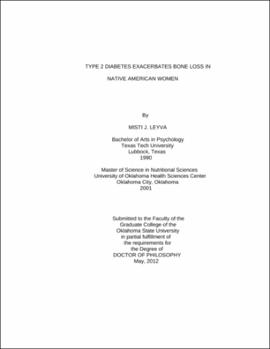| dc.contributor.advisor | Smith, Brenda J. | |
| dc.contributor.author | Leyva, Misti J. | |
| dc.date.accessioned | 2013-11-26T08:26:20Z | |
| dc.date.available | 2013-11-26T08:26:20Z | |
| dc.date.issued | 2012-05 | |
| dc.identifier.uri | https://hdl.handle.net/11244/6864 | |
| dc.description.abstract | Scope and Method of Study: Recent evidence suggests a relationship between type 2 diabetes and an increased risk of fracture. Native Americans are known to have a high prevalence of type 2 diabetes (i.e. ~2 times the national average), but the availability of evidence regarding fracture risk is limited in this population. This study was designed to examine the extent to which type 2 diabetes affects change in BMD and bone metabolism in Native American women. Participants included Native American women (n=123) 50 years of age and older, defined by their eligibility to receive services at an Indian Health Clinic. Of the total, 36% (n=44) reported a diagnosis of type 2 diabetes to which the all DM group was stratified by years post-diagnosis due to the potential for increased risk of fracture with longer diabetes duration. Baseline and final visits included DXA scans to determine BMD, relevant medical history and anthropometric measures. In addition, an optional serum sample was collected for measures of bone metabolism indicators, 25-hydroxyvitamin D3, and inflammatory mediators (e.g. TNF-? and IL-6). | |
| dc.description.abstract | Findings and Conclusions: DXA results revealed increased BMD in the hip regions of the DM group and more specifically the DM<10 years duration group. In fact the stratification of the diabetes group by duration supports the possibility of a biphasic effect evidenced by increasing BMD in the hip region the first 10 years post-diagnosis, followed by significant decreases in the same region after the first decade following diabetes diagnosis. No differences in BMD were observed in the spine or forearm regions. The only difference observed in bone metabolism was decreased CTX in the all DM group. No differences were observed between groups in inflammatory mediators or vitamin D concentrations. These findings suggest a need to clarify the use of standard methods for assessing fracture risk using BMD in type 2 diabetes due to biphasic effects of diabetes with duration. Additionally, mechanisms affecting bone metabolism in non DM models may not function similarly in a diabetic environment. The differences occurring over time between the stratified diabetes groups, is a possible indication that mechanisms are modified with disease duration. Finally, it remains to be determined if differences in this study, or lack of differences, is due to innate differences within the Native American population. | |
| dc.format | application/pdf | |
| dc.language | en_US | |
| dc.rights | Copyright is held by the author who has granted the Oklahoma State University Library the non-exclusive right to share this material in its institutional repository. Contact Digital Library Services at lib-dls@okstate.edu or 405-744-9161 for the permission policy on the use, reproduction or distribution of this material. | |
| dc.title | Type 2 diabetes exacerbates bone loss in Native American women | |
| dc.contributor.committeeMember | Johnson, Christine A. | |
| dc.contributor.committeeMember | Betts, Nancy M. | |
| dc.contributor.committeeMember | Hermann, Janice R. | |
| osu.filename | Leyva_okstate_0664D_12043.pdf | |
| osu.accesstype | Open Access | |
| dc.type.genre | Dissertation | |
| dc.type.material | Text | |
| dc.subject.keywords | bone | |
| dc.subject.keywords | fracture | |
| dc.subject.keywords | Native American | |
| dc.subject.keywords | osteoporosis | |
| dc.subject.keywords | type 2 diabetes | |
| dc.subject.keywords | women | |
| thesis.degree.discipline | Nutritional Sciences | |
| thesis.degree.grantor | Oklahoma State University | |
